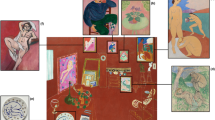Abstract
The use of the pigment Egyptian blue is investigated on a corpus of fifteen mummy portraits and Roman-period paintings from Tebtunis, Egypt, housed in the Phoebe A. Hearst Museum of Anthropology at the University of California, Berkeley. Egyptian blue has a strong luminescence response in the near infrared that can be exploited to created wide-field images noninvasively showing the distribution of the pigment on a work of art. A growing body of publications in the last decade highlights the increasing use of this tool and its sensitive detection limits. However, the technique is not wavelength specific. Both excitation and emission occur in a broad range. Although Egyptian blue has a strong emission in the NIR, a myriad of other compounds may emit light in this spectral region when excited in the visible. The limited number of studies including complementary analysis to verify the presence of Egyptian blue does not allow its identification on the basis of NIR luminescence alone. Through the use of in situ X-ray fluorescence and X-ray diffraction, and scanning electron microscopy/energy-dispersive spectroscopy of cross sections, this paper confirms the identification of Egyptian blue by NIR luminescence in unexpected areas, i.e., those not blue in appearance.






Similar content being viewed by others
References
N. Thomson, American Discovery of Ancient Egypt (Los Angeles County Museum of Art, Los Angeles, 1995), pp. 56–58
J. Williams, in Decorated Surfaces on Ancient Egyptian Objects: Technology, Deterioration and Conservation, ed. by J. Dawson, C. Rozeik, M. Wright (Archetype, London, 2010), pp. 127–138
N. Marlowe, Catalog of the Painted Portraits from Roman Egypt in the Lowie Museum Collection (University of California, Berkeley, 1982)
A. Walker, Notes on Mummy Portraits and Other Finds from Grenfell and Hunt’s Excavation at Tebtunis (1899–1900), Now in the Phoebe Hearst Museum of Anthropology (University of California, Berkeley, 1998)
S. Walker, M. Bierbrier, Ancient Faces: Mummy portraits from Roman Egypt (Trustees of the British Museum, London, 1997)
A. Pabst, Acta Crystallogr. 12, 733–739 (1959)
F. Mazzi, A. Pabst, Am. Mineral. 47, 409–411 (1962)
H. Jaksch, W. Seipel, K.L. Weiner, K.L. Weiner, A. El Goresy, Die Naturwissenschaften 70, 525–535 (1983)
T. Pradell, N. Salvado, G.D. Hatton, M.S. Tite, J. Am. Ceram. Soc. 83, 1426–1431 (2006)
M.S. Tite, M. Bimson, N.D. Meeks, Rev. Archeom. 1, 297–301 (1981)
P. Bianchetti, F. Talarico, M.G. Vigliano, M.F. Aali, J. Cult. Herit. 1, 679–692 (2000)
M.K. Hartwig, A Companion to Ancient Egyptian Art (Wiley, London, 2014)
J.E. Quibell, F.W. Green, W.M.F. Petrie, Hierakonpolis: Plates of Discoveries in 1898 (Egyptian Research Account, London, 1900)
D. Ajo’, G. Chiari, F. De Zuane, M. Favaro, M. Bertolin, in Art ‘ 96 Proceedings of the 5th International Conference on Non- Destructive Testing, Microanalytical Methods and Environmental Evaluation for Study and Conservation of Works of Art (Budapest, 1996)
G. Pozza, D. Ajo’, G. Chiari, F. De Zuane, M. Favaro, J. Cult. Herit. 1, 393–398 (2000)
G. Verri, Anal. Bioanal. Chem. 394, 1011–1021 (2009)
G. Accorsi, G. Verri, M. Bolognesi, N. Armaroli, C. Clementi, C. Miliani, A. Romani, Chem. Commun. 3392–3394 (2009). doi:10.1039/b902563d
G. Verri, in Proceedings of the SPIE, vol. 7391, ed. by L. Pezzati, R. Salimbeni. O3A, Optics for Arts, Architecture, and Archaeology II (2009), p. 739105
G. Verri, P. Collins, J. Ambers, T. Sweek, S.J. Simpson, Br. Mus. Tech. Res. Bull. 3, 57–62 (2009)
G. Verri, M. Gleba, J. Swaddling, T. Long, J. Ambers, T. Munden, Br. Mus. Tech. Res. Bull. 8, 59–71 (2014)
G. Verri, T. Opper, L. Lazzarini, in Diversamente bianco. La policromia della scultura romana, ed. by P. Liverani, U. Santamaria (Edizioni Quasar, Rome, 2014)
G. Verri, D. Saunders, Br. Mus. Tech. Res. Bull. 8, 83–92 (2014)
M. Smirniou, G. Verri, P. Roberts, A. Meek, M. Spataro, Br. Mus. Tech. Res. Bull. 4, 67–78 (2010)
P. Sarrazin, G. Chiari, M. Gailhanou, Adv. X-ray Anal. 52, 175–186 (2008)
A. Claro, M.J. Melo, S. Schafer, S. Seixtas de Melo, F. Pina, K.J. Van den Berg, A. Burnstock, Talanta 74, 922–929 (2009)
C. Minguzzi, Period. Mineral. 9, 333 (1938)
R.L.J. Lee, A.B. Fraser, The Rainbow Bridge: Rainbows in Art, Myth, and Science (Pennsylvania State University Press, University Park, 2001)
J.L. Benson, Greek Color Theory and the Four Elements. A Cosmological Interpretation (University of Massachusetts Amherst Libraries, Amherst, 2000)
V.J. Bruno, Form and Color in Greek Paintings (W. W. Norton, New York, 1977)
Acknowledgments
Research at the Northwestern University/Art Institute of Chicago Center for Scientific Studies in the Arts (NU-ACCESS) is supported by generous grant from the Andrew W. Mellon Foundation. This work made use of the EPIC facility (NUANCE Center-Northwestern University), which has received support from the MRSEC program (NSF DMR-1121262) at the Materials Research Center; the Nanoscale Science and Engineering Center (NSF EEC-0647560) at the International Institute for Nanotechnology; and the State of Illinois, through the International Institute for Nanotechnology.
Author information
Authors and Affiliations
Corresponding author
Rights and permissions
About this article
Cite this article
Ganio, M., Salvant, J., Williams, J. et al. Investigating the use of Egyptian blue in Roman Egyptian portraits and panels from Tebtunis, Egypt. Appl. Phys. A 121, 813–821 (2015). https://doi.org/10.1007/s00339-015-9424-5
Received:
Accepted:
Published:
Issue Date:
DOI: https://doi.org/10.1007/s00339-015-9424-5




